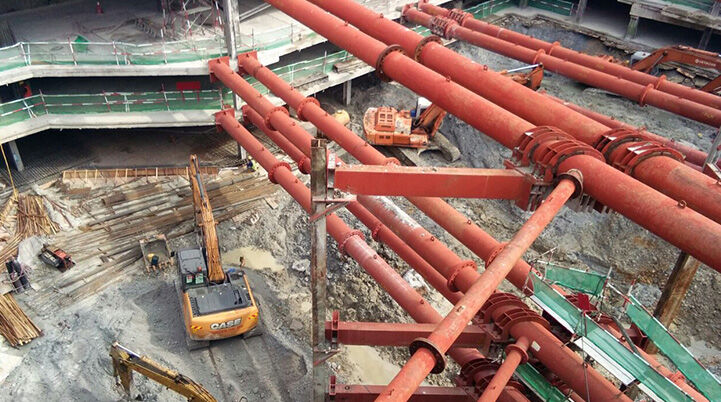Temporary Works Design (Below Ground)
The course encourages the exchange of experience by means of delegate comments and questions, group discussion and team exercises. Sessions include types of earth supports and working with earth and water pressures.
Check out the companion course Temporary Works Design (Above Ground).
Background
Temporary works is a particular source of risk on site, both from a safety and commercial points of view. Following a series of collapses in the 1970’s, the Bragg report and subsequently BS 5975 were produced to assist designers and users of temporary works.
The industry still recognises today, along with the Health and Safety Executive, the risks associated with temporary works, with the competency of the designer being a key point of concern.
Correct design, coordination and execution of temporary works is essential to the overall requirement of any project to be completed in accordance with safety, time, budget and environmental constraints.
This course [on works below-ground] is one of two courses on temporary works’ design. It is complemented by a similar course that focuses on above-ground temporary works.
Almost all construction projects of any significant size will require below-ground temporary works, which are often fundamental to the success of the scheme. The inherent variability of soil conditions can offer challenges, but problem-solving with a quantitative, calculations-based approach is not just stimulating and rewarding, but also arguably the most effective route to design assurance. The course will provide examples of both catastrophic below-ground temporary work's failures, and case studies of major projects with best-practice safety-critical temporary works at the forefront.
The course encourages the exchange of experience by means of delegate comments and questions, group discussion and team exercises. The course is equally suitable for contractors, consultants, site agents, design engineers and project managers.
Session 1 Deep Excavations
- ‘Heavy civils’ retaining wall types
- Construction Sequence
- Lateral earth (and water) pressures – scheme design
- Wall Propping
- Dewatering, effect on adjacent structures, monitoring
Session 2 General Groundworks Considerations
- Soils classification
- Soils testing
- Services diversions
Session 3 More detailed groundworks design considerations
- Pile design and construction, including vertical loading
- Medium sized retaining walls
- More detailed design methodology for lateral pressures
- Battered slopes
Session 4 Shallow Foundations
- Ground bearing bases
- Underpinning
- Working Platforms, haul roads, compaction of granular fill
Session 5 Procedural and legal considerations
Tutor
James McFarlane
The tutor is a chartered civil and chartered structural engineer, with approximately twenty years of industry experience post-graduation. As a temporary works’ designer, they have worked for both contracting and consulting organisations, in the UK and also abroad. Relevant schemes on which they have had key roles include the Battersea Power Station and Wembley Park redevelopments in London, the tunnelled sections of Crossrail [now known as the Elizabeth Line], the Dubai Metro, and the Gautrain in Johannesburg [South Africa]. The tutor remains operating in a separate role as an active practitioner, and on a near-daily basis is responsible for design, specification and inspection of below-ground temporary works for live construction projects.
As a proficient tutor and supervisor, they have delivered around 100 temporary works’ design training courses in the recent past and continue to act as a mentor for less-experienced engineering staff. In the last few years, they have also made ‘external’ presentations [about temporary works’ design] at events organised by the Construction Industry Research and Information Association [about tower crane bases], the Institution of Structural Engineers [procedural management] and the Temporary Works’ Forum [sporting stadia construction, Victorian railway engineering].
Luciana Lightman
Luciana is a Chartered Civil Engineer with over 20 years of experience in the construction industry, specialising in temporary works. With dual professional memberships in the UK (Institution of Civil Engineers) and Brazil (Regional Council of Engineering and Agronomy - Crea), Luciana brings extensive expertise in temporary works design, management, and consultancy.
Her career includes key roles in major projects, such as the refurbishment of the Old War Office and Tottenham Court Road Station, stabilisation work for several London Underground stations, the Olympic Park construction, and significant rail projects under Control Period 7 (CP7). Luciana’s contributions range from designing complex scaffolding and bespoke steel structures to developing temporary works procedures, implementing effective processes, and appointing key personnel, demonstrating her ability to address a wide range of temporary works challenges.
Since 2023, Luciana has been a member of the British Standard Institution (BSI) Committee for temporary works and the Temporary Works Forum (TWF), showing her commitment to supporting industry standards.
Luciana’s approach combines practical project experience with a focus on temporary works safety, process efficiency, and effective solutions, making her a valuable resource in temporary works training and consultancy.
At the end of the course, delegates will be able to:
• Describe the methods for design checks of below-ground temporary works.
• Recognise how site conditions affect the design of temporary works.
• Outline the process involved in temporary works design.
• Recall procedures in temporary works design, including temporary works coordination, in accordance with BS 5975: 2024
- The ability to design/check minor temporary works
- Knowledge of how site conditions affect the design of temporary works
- Knowledge of the processes involved in temporary works design
- Knowledge of the procedures in temporary works design, including temporary works coordination, in accordance with BS5975
This course is developed for:
- Design engineers wishing to specialise in temporary works, with the course acting as a general introduction to the basics of the subject.
- Temporary works coordinators / supervisors, project managers, site engineers, estimators and planners with a general knowledge of engineering design and wanting to gain greater understanding of design of basic temporary works for which they may be responsible.
Classroom/Virtual Training
Product code: C0514


